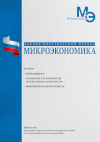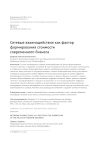Business Value Formation Process as a System of Economic Interactions
DOI: https://doi.org/10.33917/es-6.186.2022.134-141
In the article, the process of establishing the cost of modern business is considered as a system of economic interactions between economic entities. The study presents the author’s concept of the economic interactions’ typology. The author distinguishes atomistic, organic and harmonic types of economic interactions and comes to the conclusion that each of them corresponds to a certain interaction model (traditional industrial model, network model). Within each of them a mechanism of interaction, expectations, and conflict resolution is formed. Different types of economic interaction coexist simultaneously and not always in a coordinated manner. They are often intertwined. Economic subjects use a differentiated approach when interacting with each other. The focus of business strategy is shifting from internal optimization processes to coordinating external interactions, from increasing customer value to maximizing ecosystem value.
References:
1. Tszen M. Alibaba i umnyi biznes budushchego: Kak otsifrovka biznes-protsessov izmenila vzglyad na strategiyu [Alibaba and the Smart Business of the Future: How Digitalization of Business Processes has Changed the Way We Look at Strategy. Moscow, Al‘pina Pablisher, 2019, 320 p.
2. Marks K. Kapital. Kritika politicheskoi ekonomii. V 3 t. T. 1. Kn. 1. Protsess proizvodstva kapitala [Capital. Critique of Political Economy: In 3 Volumes. Vol. 1. Book. 1: The Process of Capitalist Production]. Marks K., Engel’s F. Sochineniya: V 55 t. 2-e izd. Moscow, Gospolitizdat, 1960, vol. 23, pp. 351, 430.
3. Marks K., Engel’s F. Nemetskaya ideologiya [The German Ideology]. Marks K., Engel’s F. Sobr. soch., 2-e izd. Moscow Gosudarstvennoe izd-vo politicheskoi literatury, 1955, vol. 3, pp. 480.
4. Nort D. Instituty, institutsional’nye izmeneniya i funktsionirovanie ekonomiki [Institutions, Institutional Change and Economic Performance]. Per. s angl. A.N. Nesterenko; Predisl. i nauch. red. B.Z. Mil’nera. Moscow, Fond ekonomicheskoi knigi “Nachala”, 1997, 180 p. (Sovremennaya institutsional’no-evolyutsionnaya teorii.)
5. Buaie R. Teoriya regulyatsii: kriticheskii analiz [Regulation Theory: A Critical Analysis]. Per. s fr. N.B. Kuznetsovoi. Moscow, Nauch.-izd. tsentr “Nauka dlya obshchestva”: Ros. gos. gumanit. un-t, 1997, 212 p. (Sovremennaya ekonomicheskaya mysl’.)
6. Uil’yamson O.I. Ekonomicheskie instituty kapitalizma: Firmy, rynki, “otnoshencheskaya” kontraktatsiya [Economic Institutions of Capitalism: Firms, Markets, “Relational” Contracting]. Nauch. red. i vstupitel’naya stat’ya V.S. Kat’kalo; Per. s angl. Yu.V. Blagova, V.S. Kat’kalo, D.S. Slavnova, Yu.V. Fedotova, N.N. Tsytovich. Saint Petersburg, Lenizdat; CEV Press, 1996, p. 56.
7. Anan’in O.I., Odintsova M.I. Metodologiya ekonomicheskoi nauki: sovremennye problemy i tendentsii [Methodology of Economic Science: Current Problems and Trends]. ISTOKI, Vyp. 4, Moscow, IE RAN, 2000, pp. 135, 136.





